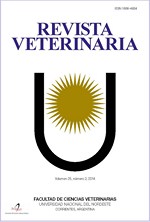Infecciones respiratorias causadas por agentes bacterianos en bovinos y ovinos de la Provincia de Corrientes, Argentina
DOI:
https://doi.org/10.30972/vet.3326177Palavras-chave:
Bovino, Ovino, Mannheimia haemolytica, Trueperella pyogenes, Pasteurella multocidaResumo
Mannheimia haemolytica, Trueperella pyogenes y Pasteurella multocida son bacterias comensales de las vías respiratorias superiores de los rumiantes. Sin embargo, cuando existen factores predisponentes pueden desencadenar enfermedades respiratorias o incluso ocasionar la muerte. El objetivo de este estudio fue determinar las causas de morbilidad y mortalidad en terneros y corderos de 4 establecimientos ubicados en la Provincia de Corrientes, Argentina. Durante los meses de junio a agosto de 2021 se recibieron en el laboratorio de Sanidad Animal del INTA Mercedes, Corrientes, 4 casos de enfermedades respiratorias, tanto en bovinos (3), como en ovinos (1). En el caso de los bovinos, los lotes presentaban una morbilidad de 3,3% (5/150), 3,5% (7/200) y 12,4% (56/450). Por su parte, el lote de ovinos expuestos contó con un 8% (4/50) de animales enfermos. Se realizó la necropsia de los ejemplares, tomando muestras de pulmón y en los casos que estuvieron disponibles, abscesos pulmonares. Con dichas muestras, se realizó el cultivo bacteriológico y análisis histológico. Mediante el cultivo bacteriológico se detectó la acción de T. pyogenes (1), M. haemolytica (2) y P. multocida (1) coincidente con los hallazgos macroscópicos y lesiones histológicas halladas. En nuestro estudio las neumonías por agentes bacterianos representaron entre el 2 y 6% de las causas de mortalidad de los rodeos analizados, por lo que deberían ser tenidas en cuenta como causante de muerte, a fin de implementar las maniobras correctivas y preventivas necesarias.Downloads
Referências
Besser TE et al. 2013. Bighorn sheep pneumonia: sorting out the cause of a polymicrobial disease. Prev Vet Med 108: 2-3, 85-93.
Biesheuvel MM et al. 2021. Emergence of fatal Mannheimia haemolytica infections in cattle in the Netherlands. Vet J 268: 105576
Brodzki P, Bochniarz M, Brodzki A, Wrona Z, Wawron W. 2014. Truepere llapyogenes and Escherichia coli as an etiological factor of endometritis in cows and the susceptibility of these bacteria to selected antibiotics. Pol J Vet Sci 17: 657-664.
Brogden KA, Lehmkuhl HD, Cutlip RC. 1998. Pasteurella haemolytica complicated respiratory infections in sheep and goats. Vet Res 29: 233-254.
Campero CM, Moore DP, Odeón AC, Cipolla AL, Odriozola E. 2003. Aetiology of bovine abortion in Argentina. Vet Res Commun 27: 5, 359-369.
Caswell JL, Williams KJ. 2016. Respiratory system: infectious respiratory diseases of sheep and goats. In: Grant Maxie M. (ed.), Jubb,
Kennedy and Palmer’s pathology of domestic animals, vol. 2, 6th ed., Missouri: Elsevier, p. 557-66.
Cohen BS, Belser EH, Keeler SP, Yabsley MJ, Miller KV. 2015. Isolation and genotypic characterization of Trueperella (Arcanobacterium) pyogenes recovered from active cranial abscess infections of male whitetailed deer (Odocoileus virginianus). J Zoo Wild Med 46: 62-67.
Dassanayake RP et al. 2013. Role of Bibersteinia trehalosi, respiratory syncytial virus, and parainfluenza-3 virus in bighorn sheep pneumonia. Vet Microbiol 162: 166-172.
Donachie M. 2001. Pasteurelosis ovina. Sitio Argentino de Producción Animal PR-Pequeños Rumiantes 2: 1, 36-44.
Dubrovsky SA et al. 2020. Pre-weaning cost of bovine respiratory disease (BRD) and costbenefit of implementation of preventative measures in calves on California dairies: the BRD 10K study. J Dairy Sci 103: 2, 1583-1597.
Farias LD et al. 2013. Outbreak of ovine respiratory mannheimiosis in southern Brazil. Rev Med Vet Zoot 20: 2, 255-259.
Holt JG, Krieg NR, Sneath PH, Staley JT, Williams ST. 1994. Bergey’s Manual of Determinative Bacteriology, 9° ed., Microbiology. Williams & Wilkins, p. 602-606.
Jost BH, Billington SJ. 2005. Arcanobacterium pyogenes: molecular pathogenesis of an animal opportunist. Anton Leeuw Int J G 88: 87-102.
Lacasta D, Ferrer LM, Ramos JJ, González JM, Heras M. 2008. Influence of climatic factor son the development of pneumonia in lambs.
Small Rumin Res 80: 28-32.
Lindström L, Tauni FA, Vargmar K. 2018. Bronchopneumonia in Swedish lambs: a study of pathological changes and bacteriological agents. Acta Vet Scand 60: 54. 1-8.
Macedo R, Arredondo V, Rodríguez J, Ramírez J, López B. 2010. Efecto del sistema de producción, de la época de nacimiento y del sexo sobre la mortalidad neonatal de corderos pelibuey. Trop Subtrop Agroecosystems 12: 77-84.
Martínez A, Apostolo R, Robles C. 2019. Bronconeumonía en corderos. Caso diagnóstico. Vet Argentina 36: 371.
Quinn PJ et al. 2011. Veterinary microbiology and microbial disease. Wiley-Blackwell. p. 245-257.
Radostits OM, Gay CC, Hinchcliff WK, Constable DP. 2006. Veterinary medicine: a textbook of the diseases of cattle, sheep, pigs, goats and horses. 10 ed., Elsevier Health Science, p. 1005-1013.
Rogovskyy AS et al. 2018. Phenotypic and genotypic characteristics of Trueperella pyogenes isolated from ruminants. J Vet Diagn Investig 30: 348-353.
Snowder GD, Vanvleck LD, Cundiff LV, Bennett GL. 2006. Bovine respiratory disease in feedlot cattle: environmental, genetic, and economic factors. J Anim Sci 84: 1999-2008.
Songer JG, Post KW. 2005. Veterinary microbiology. Bacterial and fungal agents of animal disease. Elsevier Saunders, St Louis, p. 84-91.
Timsit E, Holman DB, Hallewell J, Alexander TW. 2016. The nasopharyngeal microbiota in feedlot cattle and its role in respiratory health. Anim Front 6: 44-50.
Zecchinon L, Fett T, Desmecht D. 2005. How Mannheimia haemolytica defeats host defense through a kiss of death mechanism. Vet Res 36: 133-156.
Downloads
Publicado
Como Citar
Edição
Seção
Licença
Política de acceso abierto
Esta revista proporciona un acceso abierto inmediato a su contenido, basado en el principio de que ofrecer al público un acceso libre a las investigaciones ayuda a un mayor intercambio global de conocimiento. La publicación por parte de terceros será autorizada por Revista Veterinaria toda vez que se la reconozca debidamente y en forma explícita como lugar de publicación del original.
Esta obra está bajo una licencia de Creative Commons Reconocimiento-NoComercial 4.0 Internacional (CC BY-NC 4.0)










.jpg)
.jpg)



